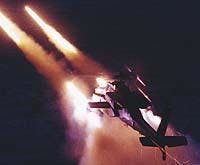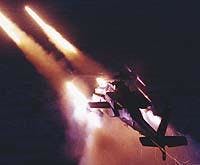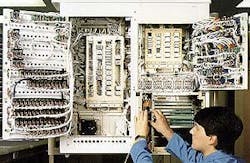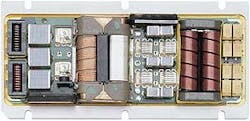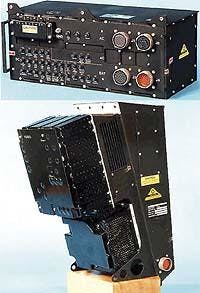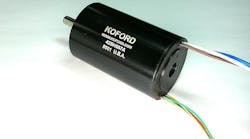By J.R. Wilson
Computer control of power distribution on aircraft and other integrated platforms is helping systems integrators improve reliability, safeguard sophisticated electronics from power spikes, and protect not only aircraft and other expensive military and aerospace systems, but also the men and women who operate them.
Platform integrators are making major strides in new power-distribution systems for military and aerospace applications. In addition to increasing reliability, integrators are making significant reductions in size and weight, as well as in acquisition, installation, and maintenance costs.
One of the newest of these developments involves solid-state power control technology — otherwise known as SSPC. This approach to aircraft systems integration replaces circuit breakers and provides much data for load-management functions such as load shedding, distribution in emergencies, and utility performance. This method of automated power load management enhances control and visibility of what is happening within the electrical system, something of special importance for the so-called electric airplanes of the future.
The first commercial aircraft application of SSPC is the Airbus A-380, which is not yet in service. The Dassault F-7 (now in development) also will have it, as does the Bombardier Global Express light passenger jet, which is in service. On the A-380, SSPC will manage more than 2,000 loads by replacing mechanical circuit breakers for a significant weight and space savings, in addition to improving reliability.
The first demonstration of SSPC was on the X-33 — a technology demonstrator for NASA's "next-generation" single-stage-to-orbit reusable space launch vehicles. X-33 systems designers used a system from Honeywell Airframe Systems in Toronto.
"SSPC provides the ability for remote programmability, enabling you to change the value at which it will trip from the cockpit or the ground," says Michael Homer, vice president for electric power systems at Honeywell Airframe Systems. "Programmability provides greater optimization of aircraft loads and, in some cases, improved safety and improved load management.
Smart tools"There is a trend in the marketplace for new technology to provide improved reliability and information [such as] intelligent load management," Homer continues. "Part of that is using solid-state power controls to enable smart load management. That involves using an intelligent circuit breaker that allows monitoring loads on the line and remote programmability — setting the circuit breaker to be tripped at any of multiple designated amp levels. This works in both AC and DC environments and offers improved reliability because you no longer have mechanical moving parts."A prime example of this new approach is the next-generation power distribution system for the U.S. Navy Northrop Grumman E2-C Hawkeye, the Navy's all-weather, carrier-based tactical warning and control system aircraft.
"When we first started the redesign of the distribution system, it was basically an update of a system designed in the late '60s and early '70s," notes Tom Carter, project engineer for E2-C systems integration at Northrop Grumman Integrated Systems in Bethpage, N.Y. "The goal was to come up with a modular, quickly replaceable, much more supportable and reliable distribution system. We also set a goal of 10 percent weight savings and increasing the power handling capability by 300 percent."
Carter says he and his engineers have gotten close to the weight reduction goal by using super lightweight machined parts and thin-wall investment casting. They also were able to size distribution on the new system to 170 KVA (Kilovolt-Amperes) nominally, per generator, compared to 60 KVA nominally or 90 for a short period of time on the original system.
"Making it modular and easily supportable was a matter of coming up with common components and arranging them in some kind of module," Carter says. Performing that design work were engineers at the Tyco Electronics Hartman Division in Mansfield, Ohio, to Northrop Grumman specifications. Tyco's primary responsibility was to design the new contactors, which are essentially very large relays, and make them not only smaller than they are today, but also capable of handling a higher power density, Carter says.
"The conventional contactor arrangement involves a big relay with studs coming out of the top and using very large-gauge wiring. Our approach was to create a very compact backplane that the contactors would simply plug into and within that backplane have a rigid busbar designed for the current load. That eliminates all of the overhead wiring of a conventional design and also allows you to remove a contactor in less than a minute, compared to about four hours with the old system."
The new E-2C architecture has a straightforward, three-phase AC 400 Hz power distribution system, a generator on each engine — each with its own generator-control system. The system involves mostly plug-and-play modules, which replace a previous design comprising one large box that was hand-wired by several mechanics over the course of several weeks.
Three-phase powerThe new technology also is helping resolve other power problems in previous versions of the the Hawkeye — some of which that deal with differences in U.S. Navy and Air Force ground systems.The Hawkeye "is a carrier-based airplane that gets its power from the ship itself while on the deck," says Ron Smith, E2-C group supervisor for electromechanical design at Northrop Grumman. "Ship's power is notoriously dirty and we had instances where it would actually damage the expensive electronics on the aircraft. So we put into the new system a check of power coming into the aircraft from the ship and making sure it is clean and acceptable. If it isn't, you can't turn the airplane on. The crew then either fixes the power station involved or goes to another station and pulls power from it."
Hawkeye technicians also had problems when pilots landed Navy aircraft at Air Force bases, where ground personnel provided power from large, cart-based generators. The original system was designed to work only with Navy carts, and required a special jumper to connect to a mechanically different Air Force cart. Without the jumper, the Air Force power cart could seriously damage the Hawkeye's electronic gear.
"The new system also protects against power systems that are just old and in need of repair, perhaps out of phase, or underpowered," Smith says. "There are two boxes in the system — the airplane takes so much power it needs two cords — that look at that incoming power all the time. Whenever the airplane is plugged into ground power, if that box doesn't like what it is seeing in real time, it will shut the airplane down." This approach is very similar to the ground power monitor employed on the Navy's F-14 jet fighter, except the Hawkeye's system uses two power monitors, he says.
"The new contactors are incredibly fast, some of the fastest I've ever seen," Smith says. "That was done because when you switch over from ground to aircraft power, you want as little interruption as possible because it can affect the equipment. Now even the crew has a hard time telling when the switch is made."
The Navy contract mandates no software in the new distribution system, which, along with the ground power monitors and generator control units, rely entirely on firmware to do the job.
The first of the new Hawkeye 2000s with the new power distribution system went to the fleet in October 2001, part of a multi-year contract for 21 aircraft for the Navy, two for Taiwan and one for France. This new version of the E-2C also includes a new mission computer, workstations, Cooperative Engagement Capability (CEC), and a cooling system.
"The French have elected to retrofit their first two aircraft, which they got some years ago, with the new distribution system," Smith says. "The U.S. Navy hasn't decided yet on whether to retrofit its existing fleet of about 73 older E2-Cs. Typically, the Navy has been retiring one older aircraft for each new one introduced, so they maintain a set fleet size."
Variable frequencyWhile the the Hawkeye's power requirements are relatively standard, a trend toward variable frequency power on platforms is accompanying the trend toward using distributed power in avionics systems."In the past, we've had 400 Hz AC power, plus or minus 20 Hz. They're trying to get away from the integrated power generator in the future to save costs, so we'll see power varying 380 to about 800 Hz," says George Schoneman, principle engineer at the Rockwell Collins Advanced Technology Center in Cedar Rapids, Iowa. "As this new trend develops, we don't want to have to redesign all our legacy equipment. Distributed power allows us to just deal with the front-end piece, which is a big advantage. So as these new trends develop on platforms, we can adapt to them more readily."
That also is an important consideration in lifetime support, which is at least 20 years for commercial aircraft — a much longer life cycle than it is for commercial non-aviation applications, and even longer for military aircraft, which may remain in service for several decades.
"There are applications where we buy COTS power converters and use them where we can, but again the 20-year lifetime becomes a problem for COTS parts," Schoneman notes. "So we do a lot of the distributed power design and equipment manufacturing in-house." That includes AC-DC converters and high density DC-DC converters.
Intelligent switching"We have to be able to load-shift various functions within the converter cabinet," Schoneman says. "When an aircraft goes on emergency power, it has to be able to shed non-essential functions. There used to be a lot of breakers, where a pilot could pop off what he didn't need, but now you have a lot more integrated functions. So smart power allows us to shut off various functions within the cabinet and keep essential functions up and running without overloading the aircraft power system."Systems designers do this with a combination of hardware that includes smart switches with controlled logic, as well as software," Schoneman says. "Sometimes we also have the need to operate from multiple input sources to provide redundancy for the power distribution center. You could have both an AC source and an emergency 28 volt DC."
Power factor correction (PFC) is a necessity in these new applications.
"The airframers are very concerned about harmonic currents and not distorting the AC bus and affecting other users on that bus or causing them to have to oversize their generators. Any converter than interfaces with the aircraft power plug requires filtering," Schoneman says.
Rockwell Collins also is now in the third year of a research project with the Office of Naval Research for high-density DC-DC converters, with a power density of 100 watts per cubic inch. In addition to a 50 percent increase in motor drive power density, project goals include 50 percent reductions in the size and weight of aircraft power conversion systems, significant increases in power, and 90 percent efficiency.
That effort is now in the technology demonstration phase. Rockwell Collins integrators will demonstrate two modules later this year — 3.3 volt output at 100 watts and 1.5 volt. Officials of the company and the Navy say they hope to drive down costs by finding a way to move some of this technology to commercial suppliers. DC-DC converters are ubiquitous components in nearly all consumer, industrial, and military electronic products.
High Density ModuleAn older but still evolving technology is the High Density Module (HDM), which made it possible for Raytheon systems integrators to redesign the power supply of the Patriot missile by incorporating advanced electronics that improved power supply reliability. Experts have applied the same technology to a host of other Army systems, including the National Missile Defense (NMD) Radar, U.S.-Israeli Arrow missile system, Theater High Altitude Area Defense (THAAD), Medium Extended Air Defense Systems (MEADS), and Joint Tactical Ground Station (JTAGS) programs.The HDM power micro-system is a commercial off-the-shelf, solid-state plug-in component. Its modular technology offers a simple, cost-effective assembly to replace larger, less reliable existing power systems. Applicable to old, pre-planned product improvement (P3I) and follow-on/new systems, HDM offers a variety of immediate acquisition and lifecycle cost savings, including elimination of component obsolescence, standardization of internal power modules, greater mission time with present fuel allotment, and fixed forward maintainability.
While the original HDM design came out around 1990, experts have made continuous improvements in the technology, including the HDM+ from Rantec Power Systems Inc. in Los Osos, Calif., which Rantec officials say offers high-output power, high efficiency, as well as low noise or emissions. This cleans the spectral content of the output.
"One of the issues surrounding HDMs has been integrating them into a system. It requires a fair amount of design work to properly integrate these converters into a power system," says Rantec chief engineer Bryan Kellogg. "Rantec coined the phrase COTS+, which means a commercial design we have ruggedized and to which we have added unique features our customers are looking for. So it's not really a commercial product any longer, but a product specially designed for military applications.
"We can provide EMI filters for the front end that comply with MIL-STD-461, power factor-corrected (PFC) modules for single-phase input and other basic building blocks for an engineer to put together a centralized power supply," Kellogg continues. "With these modules, a lot of the systems requirements — output voltage, regulation, overcurrent protection, etc. — that may be needed already are met."
HDM also offers new power options for radar and other pulse-type applications, where fast dynamic loops and large-capacity loads combine with huge levels of energy storage and capacitors. In designing such a system, an engineer could control the rate at which an HDM module charges up the capacitor bank.
Systems integrators could use EMI filtering and active PFC on a prime power input to locate the HDM modules that receive power through the bus system relatively to the loads that would use them. Depending on design requirements, designers could create a combination of the two, by attaching a central power supply with HDM, and using a distribution bus with more HDMs at the point of use. The selection of one approach over the other would depend on a variety of considerations, including thermal issues, reliability requirements, weight distribution, and TEMPEST requirements.
"Another unique feature of our HDM module is it provides current mode control, which means it has two control loops — an inner loop that is feeding back a current signal used in the controller and an outer or voltage loop that provides the voltage regulation," Kellogg says. "This enables a user, for example, to use it as a voltage-control current source, which might be used to slowly control the current going to a heater element, which would draw large amounts of current when cold, and gradually raise the current — and its temperature — as part of the warm-up prior to actual operation of a radar unit operating in a cold environment, for example.
"We also have a new product, not yet released, that will be a high-efficiency converter — an HDM module with synchronous rectification and efficiencies in the 90-plus percentile, compared to about 86-87 percent for HDM+ and 82-83 percent for standard HDM," Kellogg continues. "That new product hasn't been officially named yet, but should be available later this year."
Power of the futureMany of the distributed power and intelligent switching systems that engineers are developing or installing today also will play an important role with the arrival of the next era of power generation — the fuel cell.SatCon Technology Corp. in Cambridge, Mass., is active in fuel cell development. SatCon officials say they believe two of their current government programs will find fuel cell-related applications in the future. One of those, under a $10 million grant from the U.S. Department of Energy, involves an advanced integrated power module (AIPM) — a very dense, lightweight, low-cost approach to converting DC power from the source to AC for the user application.
Another program involves building an integrated power system for part of the electric ship program. The integrated power system is basically an inverter-separated system creating local zones of AC power; that way, if part of the ship is damaged, the rest still has power. Integrated power systems also can be used in the new electric drive military vehicles.
"The reason for distributed power in the first place was to avoid losing power due to failures in the transmission system or other problems," says SatCon president David Eisenhaure. "One way to get around that is to move the power source closer to the user. Fuel cells are a nice way to do that; they are extremely clean, but produce DC, where the big demand is for AC. We build the inverters, switch gear, and other components that turn DC into the kind of three-phase AC most users need."
Such inverters are a key enabling technology in moving to a hydrogen-powered future, he adds, and SatCon officials say they envision an inverter product line built around all types of fuel cells as a core competency and key product line in that future.
"It won't happen next year, but you'll begin to see something significant, probably first in fleets, in three years. In five years, it will be noticeable throughout the economy and in 10 years you'll forget there was ever anything else," Eisenhaure predicts. "The amount of power your house uses and what your car uses are actually very similar. So the fuel cell system and inverters you use for one could easily be adapted for the other. The same type of technology could be applied to extremely high-performance batteries for everything from Future Warrior systems to your cellphone.
"If you look at what happened in the computer industry in the past two decades and what is happening in the power industry today, there are a lot of parallels," Eisenhaure continues. "Bill Gates was one of the first to realize the key to that industry was control — in his case, the operating system. In the power industry, it also is control — control of the power flow. And that means inverters, which will make everything standardized."
